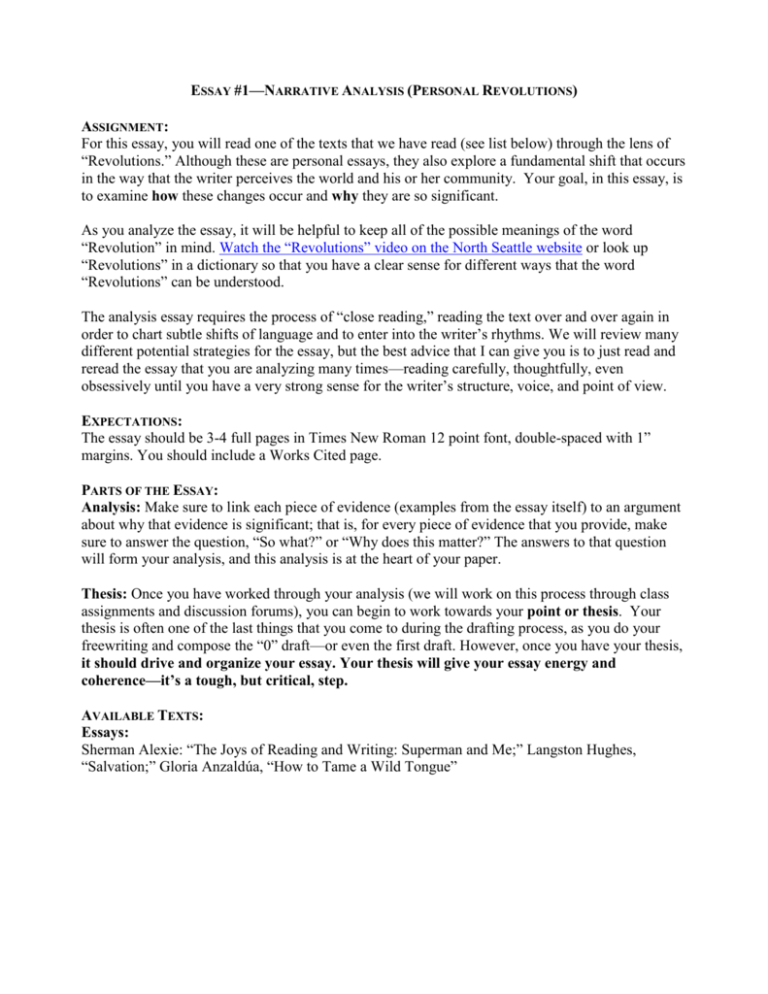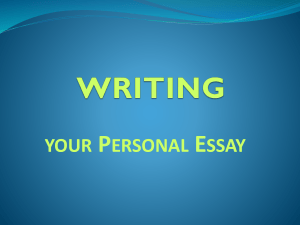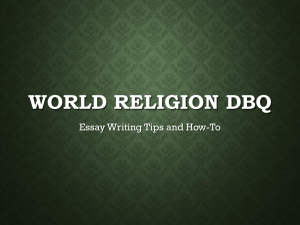Essay 1 Analysis Essay English 101
advertisement

ESSAY #1—NARRATIVE ANALYSIS (PERSONAL REVOLUTIONS) ASSIGNMENT: For this essay, you will read one of the texts that we have read (see list below) through the lens of “Revolutions.” Although these are personal essays, they also explore a fundamental shift that occurs in the way that the writer perceives the world and his or her community. Your goal, in this essay, is to examine how these changes occur and why they are so significant. As you analyze the essay, it will be helpful to keep all of the possible meanings of the word “Revolution” in mind. Watch the “Revolutions” video on the North Seattle website or look up “Revolutions” in a dictionary so that you have a clear sense for different ways that the word “Revolutions” can be understood. The analysis essay requires the process of “close reading,” reading the text over and over again in order to chart subtle shifts of language and to enter into the writer’s rhythms. We will review many different potential strategies for the essay, but the best advice that I can give you is to just read and reread the essay that you are analyzing many times—reading carefully, thoughtfully, even obsessively until you have a very strong sense for the writer’s structure, voice, and point of view. EXPECTATIONS: The essay should be 3-4 full pages in Times New Roman 12 point font, double-spaced with 1” margins. You should include a Works Cited page. PARTS OF THE ESSAY: Analysis: Make sure to link each piece of evidence (examples from the essay itself) to an argument about why that evidence is significant; that is, for every piece of evidence that you provide, make sure to answer the question, “So what?” or “Why does this matter?” The answers to that question will form your analysis, and this analysis is at the heart of your paper. Thesis: Once you have worked through your analysis (we will work on this process through class assignments and discussion forums), you can begin to work towards your point or thesis. Your thesis is often one of the last things that you come to during the drafting process, as you do your freewriting and compose the “0” draft—or even the first draft. However, once you have your thesis, it should drive and organize your essay. Your thesis will give your essay energy and coherence—it’s a tough, but critical, step. AVAILABLE TEXTS: Essays: Sherman Alexie: “The Joys of Reading and Writing: Superman and Me;” Langston Hughes, “Salvation;” Gloria Anzaldúa, “How to Tame a Wild Tongue” Narrative Analysis Assignment Rubric— Excellent—4.0-3.5 High—3.4-2.5 Average—2.4-1.9 Minimum—1.8-0 Analysis Criteria Includes a variety of engaging and specific evidence. Thoroughly analyzes the material by answering the “so what?” question for every piece of evidence that she provides. All claims are specific and supported by evidence. Explores the ideas presented in full. 27-30 pts. Includes a variety of useful evidence. Analyzes the material, answering the “so what?” question for most pieces of evidence that she provides. Most claims are specific and supported by evidence. Explores most of the ideas presented, but some of the ideas remain underdeveloped. 24-26 pts. Includes evidence, but evidence sometimes lacks variety or fails to add substance. Begins to analyze the material by answering the “so what?” question for some pieces of evidence, but significant evidence remains unanalyzed. Some claims are specific and supported by evidence; others remain unsupported. Many ideas remain underdeveloped. 21-23 pts. The essay contains insufficient evidence. The material is not adequately analyzed; the text fails to answer the “so what?” question for crucial pieces of evidence. Most of the claims are not specific or supported by evidence. The essay does not adequately develop the ideas presented. 0-20 pts. Points /30 Thesis and Topic Sentences Comments Most versions of the thesis statement and topic sentences are specific and arguable. The argument is effective most of the time, but it is unclear or under-developed in a few places. 16-17 pts. The thesis and topic sentences are specific and arguable at some points but unclear at others, or they represent a statement of fact rather than an argument. Some topic sentences are repetitive or unclear. 14-15 pts. The thesis and topic sentences are difficult to identify throughout the paper. The thesis fails to answer the question, “So what?” Topic sentences are misleading or unclear. 0-13 pts. Points / 20 Comments Style Ideas are expressed in clear, engaging prose. The writer uses specific and vivid language. The sentence lengths and types vary, and word choice is appropriate throughout. Demonstrates attention to audience and purpose. 18-20 pts. Most ideas are expressed in clear, readable prose, but a few sentences are awkward or difficult to understand. The writer uses a variety of sentence types, but some sentences could be more effective. Most word choice is appropriate. Demonstrates attention to audience and purpose. 16-17 pts. Some of the ideas are expressed in clear, readable prose, but there are many sentences that are awkward or difficult to understand. The writer uses the same sentence type throughout. Many word choices seem inappropriate. The relationship to audience or purpose is sometimes unclear. 1415 pts. Most of the prose is difficult to read. The stylistic problems impede the reader’s ability to understand the analysis and argument. Does not demonstrate an understanding of audience and purpose. 0-20 pts. Points /20 Comments: Organization Ideas are organized in a clear and logical fashion in relationship to each other (local, within paragraphs) and to the paper as a whole. Transitions are clear and effective. Includes a vivid, engaging, and informative introduction and an inventive and thorough conclusion. 18-20 pts. Ideas are organized in a clear and logical fashion in relationship to each other (local, within paragraphs) and to the paper as a whole. Most transitions are clear and effective, but a few are confusing. Includes an appropriate introduction and a thorough conclusion. 16-17 Although ideas are generally organized in a logical fashion, some sentences or paragraphs are unorganized or unrelated to the main idea or paragraph. Transitions are often lacking, leaving the reader lost. Includes an adequate intro. And/or conclusion. 14-15 pts. Discernible organization is minimal or nonexistent. Underdeveloped or missing introduction and/or conclusion. Minimal or no transitions between paragraphs. 0-13 Points /20 Mechanics/ Proofreading Comments: Some noticeable variety of sentences with correct sentence structure. Infrequent grammatical, proofreading, or mechanics errors. (Errors do not disrupt the flow or clarity of the text.) 8 pts Though there are some strong sentences, there are more than 2-4 sentence structure problems. Grammatical, proofreading, and mechanical errors sometimes impede flow or clarity. 7 pts Frequent sentence structure problems. Sentence level, grammatical, and mechanics problems seriously impede the clarity of the text. 6 pts. Points / 10 Comments: The thesis statement and topic sentences are specific and arguable, answering the question, “So what?” 18-20 pts. Full variety of sentence structures used with no sentence level errors. No grammatical, proofreading, or mechanics errors. 9-10 pts Total: /100








